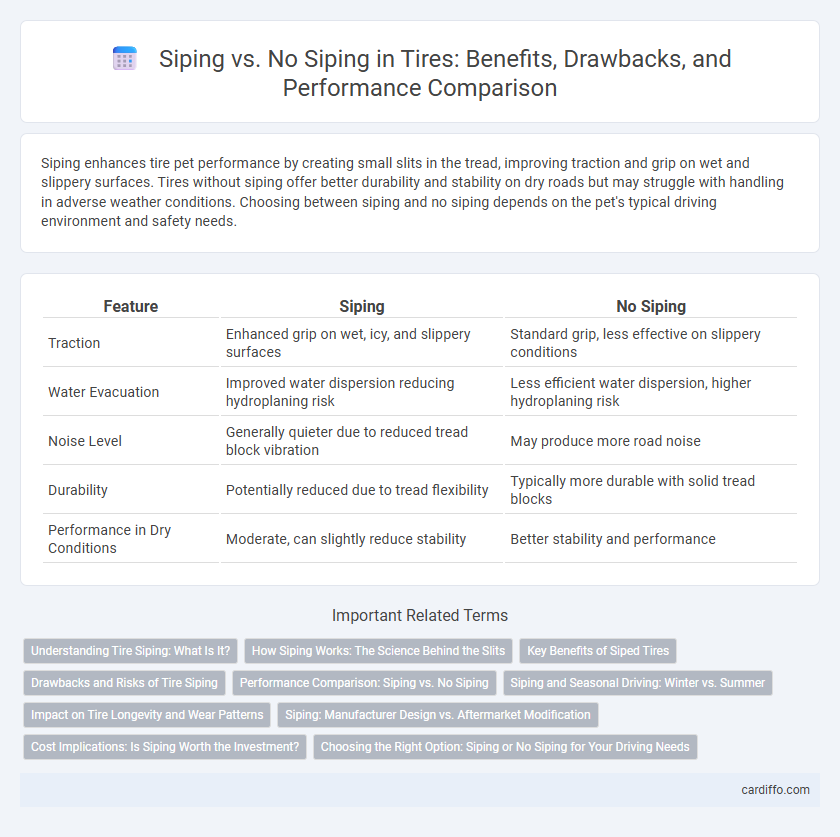Siping enhances tire pet performance by creating small slits in the tread, improving traction and grip on wet and slippery surfaces. Tires without siping offer better durability and stability on dry roads but may struggle with handling in adverse weather conditions. Choosing between siping and no siping depends on the pet's typical driving environment and safety needs.
Table of Comparison
| Feature | Siping | No Siping |
|---|---|---|
| Traction | Enhanced grip on wet, icy, and slippery surfaces | Standard grip, less effective on slippery conditions |
| Water Evacuation | Improved water dispersion reducing hydroplaning risk | Less efficient water dispersion, higher hydroplaning risk |
| Noise Level | Generally quieter due to reduced tread block vibration | May produce more road noise |
| Durability | Potentially reduced due to tread flexibility | Typically more durable with solid tread blocks |
| Performance in Dry Conditions | Moderate, can slightly reduce stability | Better stability and performance |
Understanding Tire Siping: What Is It?
Tire siping refers to the small, thin slits cut into the tread blocks to enhance traction by increasing the tire's grip on wet, icy, or slippery surfaces. Tires with siping provide improved water evacuation and reduce hydroplaning risk, offering superior handling and safety in adverse weather conditions compared to tires without siping. However, unsiped tires often deliver better performance on dry roads due to increased tread block rigidity, making siping a critical consideration for specific driving environments.
How Siping Works: The Science Behind the Slits
Siping refers to the small, thin slits cut across a tire's tread, designed to improve traction by creating additional biting edges that enhance grip on wet, icy, or slippery surfaces. These slits allow the tread blocks to flex and adapt to the road, channeling water away and reducing the risk of hydroplaning. Tires without siping rely solely on their tread pattern for traction, which can limit performance in challenging driving conditions where additional surface contact is crucial.
Key Benefits of Siped Tires
Siped tires feature small, precise slits that enhance traction on wet, icy, and snowy surfaces by improving water and slush evacuation from the tread. These tires offer superior grip, reduced hydroplaning risk, and increased braking efficiency compared to non-siped tires. Enhanced flexibility in the tread blocks also contributes to a smoother, safer driving experience in adverse weather conditions.
Drawbacks and Risks of Tire Siping
Tire siping improves traction by creating additional biting edges, but it can also lead to faster tread wear and reduced tire durability under heavy loads or high-speed driving. Siped tires often have increased heat buildup, which raises the risk of premature tire failure and blowouts, especially in warm climates. Inconsistent siping patterns can cause uneven tread wear, negatively impacting handling and overall tire performance.
Performance Comparison: Siping vs. No Siping
Siping enhances tire performance by improving traction on wet, icy, and slippery surfaces through increased edge biting, resulting in better grip and shorter braking distances. Tires without siping typically offer greater tread block stability and longer tread life on dry surfaces but may compromise control in adverse weather conditions. Selecting between siped and non-siped tires depends on specific driving environments, prioritizing either wet traction or dry-road durability.
Siping and Seasonal Driving: Winter vs. Summer
Siping enhances tire traction by creating additional biting edges that improve grip on snow and ice, making it crucial for winter driving conditions. In contrast, tires without siping perform better on dry summer roads due to increased tread block stability and reduced wear. Seasonal driving demands selecting the appropriate tire design, with siped tires favoring winter safety and non-siped tires optimizing summer performance and durability.
Impact on Tire Longevity and Wear Patterns
Siping improves tire longevity by enhancing traction and reducing uneven wear, especially on wet and slippery surfaces. Tires without siping tend to wear faster in localized areas due to less effective water dispersion and reduced grip. The microscopic cuts in siped tires allow flexible tread movement, promoting even contact with the road and extending tire life.
Siping: Manufacturer Design vs. Aftermarket Modification
Siping involves cutting thin slits into tire tread to enhance traction and water evacuation, a design feature carefully engineered by manufacturers to ensure optimal performance and durability. Manufacturer-designed siping maintains precise patterns and depths tailored to specific tire compounds and road conditions, balancing grip with tread life. Aftermarket modifications, while potentially improving traction, often lack the precision and consistency of factory siping, risking uneven wear, reduced tire integrity, and compromised safety.
Cost Implications: Is Siping Worth the Investment?
Siping enhances tire traction by creating additional biting edges, improving safety in wet or icy conditions, yet it often raises the initial cost and complexity of tire manufacturing. Tires without siping generally offer a lower upfront price and may wear longer on dry roads but can compromise grip and increase the risk of hydroplaning. Evaluating cost effectiveness depends on driving conditions, where siping justifies investment for frequent wet or snowy environments, while no siping suits dry climates and budget-conscious consumers.
Choosing the Right Option: Siping or No Siping for Your Driving Needs
Siping enhances tire traction by creating additional biting edges, improving grip on wet, icy, or snowy surfaces, which is ideal for drivers in regions with variable weather conditions. Tires without siping generally provide better stability and performance on dry roads, making them suitable for high-speed driving or warm climates. Selecting the right option depends on your typical driving environment and priorities, balancing enhanced safety on slippery roads against optimal handling on dry pavement.
Siping vs No siping Infographic

 cardiffo.com
cardiffo.com